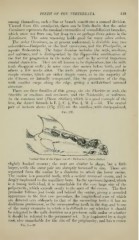Page 439 - My FlipBook
P. 439
—
TEETH OF THE VERTEBRATA. 449
among themselves, siu-li a line or branch constitutes a natural division.
Viewed from this standpoint, there can be little doubt that the order
Oirnivoni represents the terminal extremities of several distinct branches,
Avhich arose not from one, but from two or perhaps three points in the
Insectivora. The same reasoning holds good for many other orders.
The order Garnivora, as at present understood, is divisible into two
sub-orders Fissipedia, or the land carnivores, and the P'uinipedia, or
aquatic flesh-eaters. The latter division includes the seals, sea-lions,
and walruses, and is distinguished bv the fiippei-like modification of
the feet for progression in the water, as well as bv several important
cranial characters. They are all known to be diphyodont, but the milk
teeth disappear early ; in some cases this occurs before birth, and in
others a few weeks after. The teeth always possess comparatively
simple crowns, which are either simple cones, as in the majority of
the Cetacca, or laterally compressed, like the premolars of the dog,
with smaller cusps along the edge, giving a well-defined serrated
structure.
There are three families of this group, viz. the Phocidce or seals, the
Otaridce or sea-lions and sea-bears, and the Trichecidce, or walruses.
In the common seal [Phoca ritiUina), which is a good exara])le of the
first, the dental fonnula is I. f , C. |, Pni. f , M. | = 34. The central
pair of incisors above (Fig. 227) are the smallest, with sharp-pointed,
Fig. 227.
Vertical View of the Upper Jaw of a Harbor Seal {I'Uoca vituiinn).
slightly hooked crowns ; the next are similar in shape, but a little
larger, while the outer pair are abruptly increased in size. These are
separated from the canine by a diastema to admit the lower canine.
The canine is a powerful tooth, with a conical recurved crown, and is
deeply implanted in the maxillary bone. In the specimen figured, which
is a young individual, it is remarkable for the very large size of the
pulp-cavity, which extends nearly to the apex of the crown. The first
premolar follows just inside and behind the canine, giving a crowded
appearance to the first two premolars, the longitudinal axes of wliich
are directed very obliquely to that of the succeeding teeth it has no
:
deciduous predecessor, as the corresponding tooth in the dog, and is one
of the many examples in which it is difficult to say whether it should
be relegated to the milk dentition as a persistent milk molar or whether
it should be referred to the permanent set. It is implanted bv a single
root, also remarkable for the size of the pulp-cavity, and has a crown
Vol. I.—29
TEETH OF THE VERTEBRATA. 449
among themselves, siu-li a line or branch constitutes a natural division.
Viewed from this standpoint, there can be little doubt that the order
Oirnivoni represents the terminal extremities of several distinct branches,
Avhich arose not from one, but from two or perhaps three points in the
Insectivora. The same reasoning holds good for many other orders.
The order Garnivora, as at present understood, is divisible into two
sub-orders Fissipedia, or the land carnivores, and the P'uinipedia, or
aquatic flesh-eaters. The latter division includes the seals, sea-lions,
and walruses, and is distinguished bv the fiippei-like modification of
the feet for progression in the water, as well as bv several important
cranial characters. They are all known to be diphyodont, but the milk
teeth disappear early ; in some cases this occurs before birth, and in
others a few weeks after. The teeth always possess comparatively
simple crowns, which are either simple cones, as in the majority of
the Cetacca, or laterally compressed, like the premolars of the dog,
with smaller cusps along the edge, giving a well-defined serrated
structure.
There are three families of this group, viz. the Phocidce or seals, the
Otaridce or sea-lions and sea-bears, and the Trichecidce, or walruses.
In the common seal [Phoca ritiUina), which is a good exara])le of the
first, the dental fonnula is I. f , C. |, Pni. f , M. | = 34. The central
pair of incisors above (Fig. 227) are the smallest, with sharp-pointed,
Fig. 227.
Vertical View of the Upper Jaw of a Harbor Seal {I'Uoca vituiinn).
slightly hooked crowns ; the next are similar in shape, but a little
larger, while the outer pair are abruptly increased in size. These are
separated from the canine by a diastema to admit the lower canine.
The canine is a powerful tooth, with a conical recurved crown, and is
deeply implanted in the maxillary bone. In the specimen figured, which
is a young individual, it is remarkable for the very large size of the
pulp-cavity, which extends nearly to the apex of the crown. The first
premolar follows just inside and behind the canine, giving a crowded
appearance to the first two premolars, the longitudinal axes of wliich
are directed very obliquely to that of the succeeding teeth it has no
:
deciduous predecessor, as the corresponding tooth in the dog, and is one
of the many examples in which it is difficult to say whether it should
be relegated to the milk dentition as a persistent milk molar or whether
it should be referred to the permanent set. It is implanted bv a single
root, also remarkable for the size of the pulp-cavity, and has a crown
Vol. I.—29


